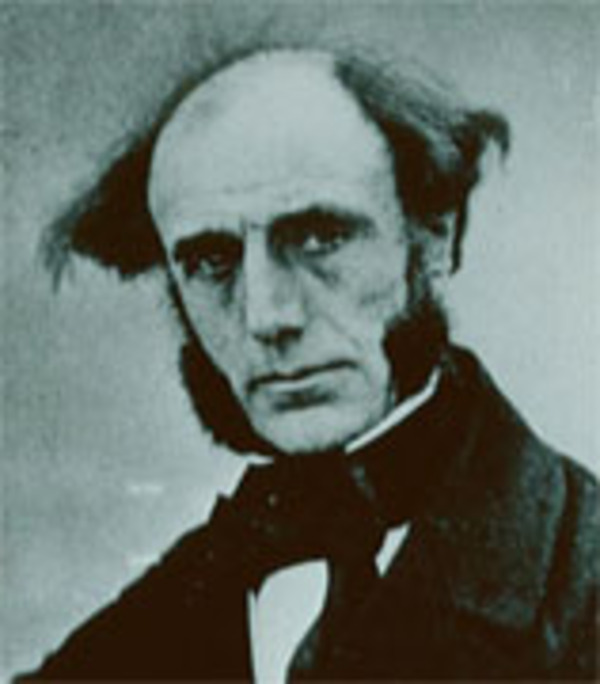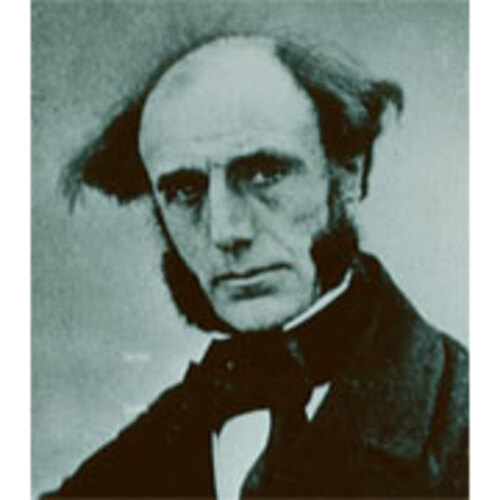
Source: Link
JOHNSTON, JAMES FINLAY WEIR, agricultural chemist, mineralogist, and author; b. 13 Sept. 1796 in Paisley, Scotland; m. 1830 one of the daughters of Thomas Ridley of Durham, England; d. 18 Sept. 1855 in Durham.
James Finlay Weir Johnston spent his childhood in Paisley and in Manchester, England, and Kilmarnock, Scotland. Although his formal education was sparse, he enrolled as a student of theology at the University of Glasgow in 1823, supporting himself by acting as a private tutor. He received an ma and a silver medal in philosophy in 1826 but continued on the rolls of the university until 1828. He operated a school in Durham from 1825 to 1830, when his marriage brought him a “competent income” that allowed him to abandon the school and pursue work in chemistry.
In 1833, after studying with the famous Swedish chemist, Jöns Jacob Berzelius, Johnston was appointed reader in chemistry and mineralogy at the newly founded University of Durham, a post he retained until his death. A fellow of the royal societies of London and Edinburgh, Johnston was elected to fellowships in the geological and chemical societies; he also became an honorary member of the Royal Agricultural Society of England and a foreign member of the Royal Swedish Academy of Agriculture, and was chemist to the Agricultural Society of Scotland. Widely travelled and highly respected, Johnston sought to turn scientific knowledge to practical application and published many extremely popular works in agricultural chemistry. His Catechism of agricultural chemistry and geology, first published in 1844, went through 33 English editions in his lifetime, was translated into numerous languages, and was widely used in schools on both sides of the Atlantic. Among Johnston’s other publications, Lectures on agricultural chemistry and geology and The chemistry of common life were influential. He also contributed articles and papers to the Royal Society, the British Association for the Advancement of Science, the Royal Agricultural Society, Blackwood’s Edinburgh Magazine, and the Edinburgh Review.
In 1848, at the invitation of the New York State Agricultural Society, Johnston made plans to visit North America. New Brunswick, which was later added to his itinerary, was suffering a recession due to the reduction of Britain’s preferential tariff on timber which had caused a decline in the staple trade of the colony, and there was considerable interest in revitalizing the province’s economy. Well-worn arguments for agricultural self-sufficiency were reiterated, and the slowness of immigration to the province was lamented. Official and lay reports attributed this slowness to “a want of information as to [New Brunswick’s] position and resources” in Britain. When news of Johnston’s trip reached Saint John late in 1848, Moses Henry Perley* and other members of the local agricultural society recognized an opportunity to publicize the farming potential of New Brunswick, and asked Lieutenant Governor Sir Edmund Walker Head* to invite Johnston to the colony. The House of Assembly agreed to finance the venture and in June 1849, just weeks before his departure, Johnston agreed to report on the agricultural capabilities of the province.
Neither Johnston nor the provincial authorities clearly appreciated the implications of their arrangement. On his arrival, Johnston recognized that “the extent of the province, and the slow rate of travelling, would compel [him] . . . to devote some months longer to the work” than he had anticipated. The cost to the government ultimately amounted to £500, exclusive of travelling expenses incurred by Johnston and his provincial assistants James Robb* and James Brown*; Johnston’s energy and vision, however, enabled him to accomplish the task with remarkable dispatch. Although most of September and early October 1849 were given to his business in New York, he spent 53 days between August and November travelling some 2,000 miles of New Brunswick roads. In the six weeks before Christmas he wrote his sweeping yet detailed Report. The conviction that geological structure revealed agricultural potential was central to his interpretation of provincial capabilities. He devoted much effort to deciphering the still imperfectly known geology of New Brunswick and appended both geological arid pedological maps to his report. But this deductive methodology was complemented by inductive empiricism. He sought responses to a series of questions which he had published in provincial newspapers, visited officials of local agricultural societies, talked with many farmers on his travels, and was an indefatigable observer of the landscapes through which he passed. Indeed, he saw the major virtue of his Notes on North America, agricultural, economical, and social (1851) in its presentation of the “matter-of-fact information” on the lower St Lawrence and New Brunswick revealed by his “agricultural eye.”
Johnston’s public appraisal of New Brunswick’s agricultural potential, given in an address at Saint John in December 1849 and in his published Report (1850), was optimistic. The soils of New Brunswick were more productive than those in New York and Ohio, New Brunswick farmers achieved greater financial returns than did their counterparts in Upper Canada, and the land could sustain a population of perhaps four million. These conclusions were widely acclaimed within the province, where the sluggish economy seemed to deny conviction that progress and prosperity were possible. Sceptics who suggested that Johnston’s information came from the most successful farmers on the best lands in the province were denounced, and the Report’s recommendations for a more scientific agriculture were commended to provincial settlers. Enthusiasm about agricultural matters grew. Soon after Johnston’s arrival in the province James Robb had been instrumental in establishing the New Brunswick Society for the Encouragement of Agriculture, Home Manufactures, and Commerce. In 1851 a New Brunswick edition of Elements of scientific agriculture by Johnston’s student, John Pitkin Norton, was published. The Report had gone into a second edition in 1850, with 10,000 copies intended for distribution in England. Thirteen years later, more copies of the Report were delivered by James Brown to communities in Britain to promote immigration to New Brunswick, and Johnston’s Catechism was published at Saint John in 1861.
The immediate purposes of Johnston’s visit to New Brunswick were served. His skill and experience infused energy into provincial proponents of improved agriculture and his writings helped publicize the colony in Britain. But in the long term, Johnston’s impact was limited. Both immigration and scientific agriculture remained relatively uncommon in late-19th-century New Brunswick, and experience revealed that Johnston’s appraisal of the province’s agricultural potential was far too sanguine.
James Finlay Weir Johnston wrote extensively on the application of science to agriculture. The following works, originally published in Edinburgh and London, were among the most influential: Lectures on agricultural chemistry and geology . . . (1841), Catechism of agricultural chemistry and geology (1844), and The chemistry of common life (2v., [1853–55]), all of which went through many editions. The DNB and the National union catalog give some indication of the scope and popularity of his writings although neither work provides a comprehensive list.
Johnston’s main North American publications are his Report on the agricultural capabilities of the province of New Brunswick (1st and 2nd eds., Fredericton, 1850) and the two-volume Notes on North America, agricultural, economical, and social (Edinburgh and London, 1851; also published Boston, 1851). In addition, his Saint John address was published under the title The agricultural capabilities of the province of New-Brunswick, British North America; an address delivered before the Mechanics’ Institute of the city of Saint John, New-Brunswick, on Friday evening, December 21st, 1849 (Saint John, 1850), as were two editions of his address to the New York State Agricultural Society. Lectures on the general relations which science bears to practical agriculture, delivered before the New-York State Agricultural Society (New York, 1850) apparently prints Johnston’s own text; a version entitled Lectures on the general relations of science to agriculture . . . delivered before N.Y. State Agricultural Society, January, 1850, reported by Sherman Croswell (Albany, N.Y., 1850), was issued by the society.
The impact of Johnston’s visit to North America is reflected by the popularity of a work by his student, J. P. Norton, Elements of scientific agriculture . . . , which was first published in Albany in 1850, went through many subsequent American editions, and appeared in a New Brunswick edition at Saint John in 1851, and by the publication of a 40th edition of Johnston’s Catechism of agricultural chemistry and geology for use in New Brunswick schools (Saint John, 1861).
PANB, RG 2, RS7, 31–32; RG 3, RS13, A7. Gentleman’s Magazine, July–December 1855: 545. Northumberland Agricultural Soc., Report (Miramichi, N.B.), 1849–50. “Professor Johnston’s last work,” Blackwood’s Edinburgh Magazine (Edinburgh and London), 78 (July–December 1855): 548–61. Saint John Agricultural Soc., Annual report ([Saint John?]), 1848; Proceedings at the annual meeting, with the report of the directors (Saint John), 1850. New-Brunswick Courier, 1849–50. Graeme Wynn, “The assault on the New Brunswick forest, 1780–1850” (phd thesis, Univ. of Toronto, 1974). C. A. V. Barker, “M. A. Cuming, V.S. (Edin.), M.R.C.V.S.: a biography and the inducement to settle in New Brunswick in 1852,” Canadian Veterinary Journal (Ottawa), 17 (1976): 123–35.
Cite This Article
Graeme Wynn, “JOHNSTON, JAMES FINLAY WEIR,” in Dictionary of Canadian Biography, vol. 8, University of Toronto/Université Laval, 2003–, accessed January 10, 2026, https://www.biographi.ca/en/bio/johnston_james_finlay_weir_8E.html.
The citation above shows the format for footnotes and endnotes according to the Chicago manual of style (16th edition). Information to be used in other citation formats:
| Permalink: | https://www.biographi.ca/en/bio/johnston_james_finlay_weir_8E.html |
| Author of Article: | Graeme Wynn |
| Title of Article: | JOHNSTON, JAMES FINLAY WEIR |
| Publication Name: | Dictionary of Canadian Biography, vol. 8 |
| Publisher: | University of Toronto/Université Laval |
| Year of publication: | 1985 |
| Year of revision: | 1985 |
| Access Date: | January 10, 2026 |



